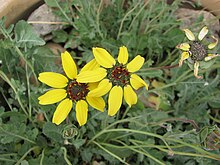
Gaillardia is a genus of flowering plants in the family Asteraceae, native to North and South America. It was named after Maître Gaillard de Charentonneau, an 18th-century French magistrate who was an enthusiastic botanist. The common name may refer to the resemblance of the inflorescence to the brightly patterned blankets made by Native Americans, or to the ability of wild taxa to blanket the ground with colonies. Many cultivars have been bred for ornamental use.

Silphium is a genus of North American plants in the tribe Heliantheae within the family Asteraceae.

Nolina is a genus of tropical xerophytic flowering plants, with the principal distribution being in Mexico and extending into the southern United States. They are large, dioecious plants.

Helianthus is a genus comprising about 70 species of annual and perennial flowering plants in the daisy family Asteraceae commonly known as sunflowers. Except for three South American species, the species of Helianthus are native to North America and Central America. The best-known species is the common sunflower. This and other species, notably Jerusalem artichoke, are cultivated in temperate regions and some tropical regions, as food crops for humans, cattle, and poultry, and as ornamental plants. The species H. annuus typically grows during the summer and into early fall, with the peak growth season being mid-summer.

Palafoxia, or palafox, is a genus of North American flowering plants in the Bahia tribe within the Asteraceae.

Gaillardia pulchella is a North American species of short-lived perennial or annual flowering plants in the sunflower family.

Bouteloua is a genus of plants in the grass family. Members of the genus are commonly known as grama grass.

Heterotheca, are North American plants in the family Asteraceae.
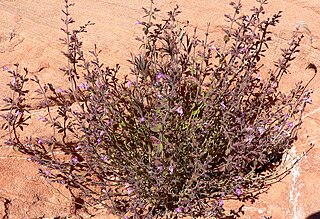
Hedeoma is a genus of flowering plants in the mint family, Lamiaceae. It is native to North and South America. They are commonly known as false pennyroyals.

Erigeron divergens is a species of flowering plant in the family Asteraceae known by the common name spreading fleabane. It is native to western North America.
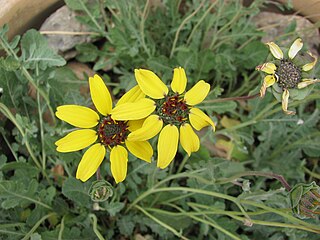
Berlandiera lyrata, with the common names chocolate flower, chocolate daisy, or lyreleaf greeneyes, is a North American species of flowering plant in the family Asteraceae. The common name lyreleaf greeneyes is a reference to the shape of the leaf, which is curved like a lyre and the green disc which is left behind when the ray florets drop off which is thought to look like an eye.
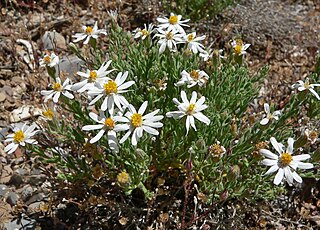
Chaetopappa is a genus of plants in the family Asteraceae which are known generally as leastdaisies.
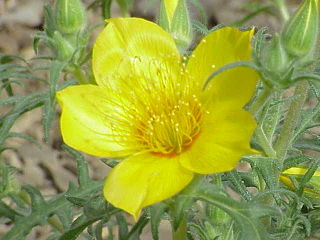
Mentzelia pumila, is a biennial wildflower found in the western United States and northwestern Mexico from Montana and North Dakota, south to Sonora and Chihuahua. It is a blazingstar and a member of the genus Mentzelia, the stickleafs; member species are also called "evening stars", but some stickleafs close at sunset, as does M. pumila.
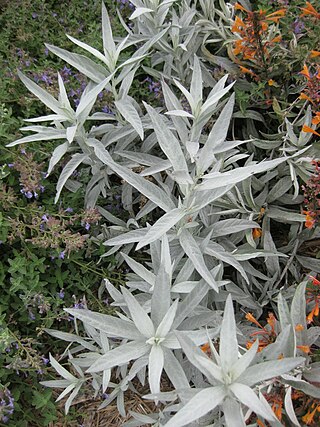
Artemisia ludoviciana is a North American species of flowering plant in the daisy family Asteraceae, known by several common names, including silver wormwood, western mugwort, Louisiana wormwood, white sagebrush, lobed cud-weed, prairie sage, and gray sagewort.

Grindelia ciliata is a species of flowering plant in the family Asteraceae known by the common names Spanish gold, goldenweed, and waxed goldenweed.
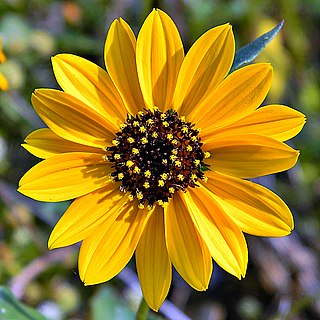
Helianthus debilis is a species of sunflower known by the common names cucumberleaf sunflower, beach sunflower, weak sunflower, and East Coast dune sunflower. It is native to the United States, where it can be found along the Atlantic and Gulf Coasts. It is known elsewhere as an introduced species, such as South Africa, Australia, Taiwan, Slovakia, and Cuba.
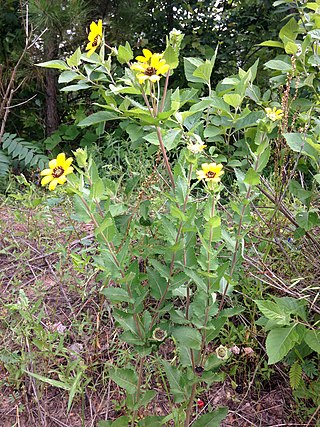
Berlandiera texana is a North American species of flowering plant in the family Asteraceae. It is commonly known as Texas greeneyes. It is native to the south-central United States, in the states of Texas, New Mexico, Oklahoma, Kansas, Missouri, Arkansas, and Louisiana.
Berlandiera pumila, the soft greeneyes, is a North American species of flowering plant in the family Asteraceae. It is native to the southeastern and south-central United States.
Erigeron bellidiastrum, the western daisy fleabane or sand fleabane, is a species of fleabane in the family Asteraceae. It is native to northern Mexico and the western and central United States.

Calyptocarpus vialis is a species of flowering plant in the family Asteraceae. Common names for C. vialis include straggler daisy, horseherb, lawnflower, and creeping Cinderella-weed. It is native to south Texas, Mexico, Belize, Venezuela, and the Caribbean. It has also been introduced east of Texas, Argentina, Hawaii, India, Java, Australia, and Taiwan. It is one of only three species in the genus Calyptocarpus.
